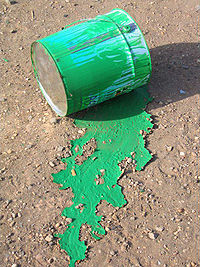VOCs: Why Your New Paint Job Shouldn’t Smell Like Paint

Spring cleaning is upon us. Maybe this year, for you, that means a new paint job – if so, Grist’s Umbra Fisk has green advice for you in her eco-paint 101 video blog, recently posted online. Most conventional paints used today are chemical-based and unnecessarily toxic. They contain the VOCs (volatile organic compounds) that give conventional paint its strong smell. So if you can smell your paint, you can bet it’s not doing you or the planet any good. What it’s doing is offgassing harmful ozone, aggravating respiratory health problems, causing headaches and possibly even kidney and liver damage, according to the EPA.
The EPA also recognizes that chemical-based paints are a big part of why indoor air quality can actually be 2-5 times worse than outdoor air quality, even in cities. VOC concentrations can be up to ten times higher indoors than out. On the bright side: we do have much more control over the quality of the air we breathe indoors than the air we breathe outdoors. And fortunately, paints labeled “low-“ or “no-VOC” are easier and easier to find these days, don’t list toxins like ethylene glycol on their ingredient lists, and work just as well as the old stuff, according to Green Depot’s store manager, Ana Paglioni.
For zero-VOC brand recommendations, check out National Geographic’s Green Guide Paint Database. And consider Milk Paint, a company that’s been around since the first Earth Day 40 years ago, whose milk-based non-toxic paint comes as a dehydrated powder – in bags rather than in tubs – so as to cut down on CO2 emitted during shipping.




